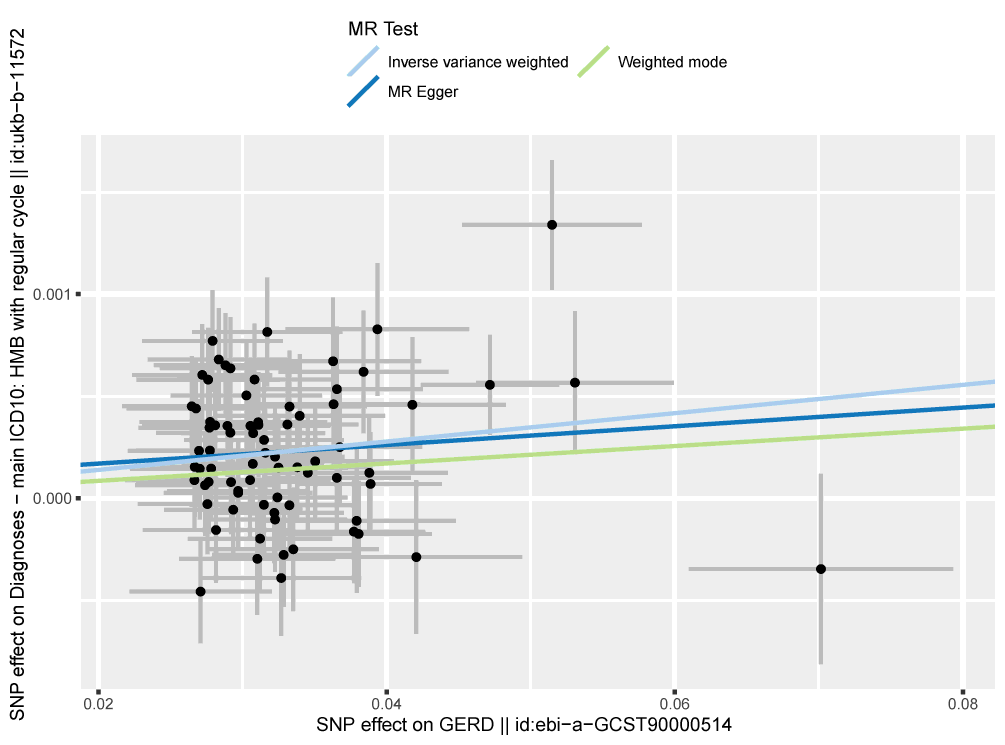In a recent study posted to the preprint* server Research Square while under review for publication in BMC Medical Genomics, researchers investigate the potential causal relationship between gastroesophageal reflux disease (GERD) and the risk of heavy menstrual bleeding (HMB) during regular menstrual cycles.
 Study: A causal association between gastroesophageal reflux disease and risk of heavy menstrual bleeding with regular cycle: A Mendelian randomization study. Image Credit: Africa Studio / Shutterstock.com
Study: A causal association between gastroesophageal reflux disease and risk of heavy menstrual bleeding with regular cycle: A Mendelian randomization study. Image Credit: Africa Studio / Shutterstock.com

 *Important notice: Research Square publishes preliminary scientific reports that are not peer-reviewed and, therefore, should not be regarded as conclusive, guide clinical practice/health-related behavior, or treated as established information.
*Important notice: Research Square publishes preliminary scientific reports that are not peer-reviewed and, therefore, should not be regarded as conclusive, guide clinical practice/health-related behavior, or treated as established information.
What is GERD?
GERD is a widespread gastrointestinal issue characterized by chest burning and is often diagnosed through symptom evaluation and endoscopy. The chronicity of GERD is attributed to genetics, body mass index (BMI), smoking, and potentially female hormones.
HMB, which impacts two to five out of every 10 women, significantly diminishes well-being and is linked to symptoms like nausea. The primary causes of HMB range from uterine problems and systemic disorders to certain medications.
Notably, the connection between GERD and regular-cycle HMB remains underexplored, with some studies suggesting a potential role of estrogen in GERD symptoms.
About the study
The genome-wide association study (GWAS) database was utilized for obtaining data from numerous GWAS, from which summary statistics for GERD and HMB, both of European descent populations, were obtained. Specific statistical criteria were used to isolate single nucleotide polymorphism (SNPs) associated with GERD, which led to the identification of 75 SNPs. These SNPs underwent further analysis to gauge their relevance to GERD and HMB.
Mendelian randomization (MR) was used to determine the correlation of each SNP to GERD and the association between these SNPs and the risk of HMB in regular menstrual cycles. MR analysis was also used to ascertain the causal relationship between GERD and HMB.
The inverse-variance weighted (IVW) method, MR-Egger regression, and weighted median estimator were used to provide statistical analysis discerning the causality between GERD and menstrual cycles.
Study findings
A total of 75 SNPs were identified from GWASs on GERD for use as instrumental variables (IVs), with four SNPs excluded during data analysis. These SNPs had a positive association with HMB in regular menstrual cycles, which was supported by specific P-value and F-statistic criteria.
Through the IVW method, evidence supporting a causal link between GERD and HMB during regular cycles was observed. However, the MR-Egger method, which was utilized to inspect potential directional pleiotropy, did not indicate a causal link. Conversely, the weighted median method suggests there might be a causal relationship; however, the results were inconclusive.
Upon comparing the methods, the IVW method exhibited greater precision. Given the consistent direction across all models, the Mendelian randomization analysis suggests a potential causal link between GERD and HMB during regular menstrual cycles.
There was no significant evidence of horizontal pleiotropy; however, potential signs of heterogeneity were identified. Notably, no single SNP dominated the IVW estimate. Even when considering potential biases in MR methods due to horizontal pleiotropy, both the funnel plot and MR-Egger regression showed consistent results, thus implying no evident asymmetry.

Scatter plots of genetic associations with GERD against the genetic associations with HMB with normal menstrual cycles. The slopes of each line represent the causal association for each method. The blue line represents the inverse‐variance weighted estimate, the green line represents the weighted median estimate, and the dark blue line represents the Mendelian randomization‐Egger estimate.
Conclusions
GERD is a complex disorder encompassing various syndromes intensified by gastroesophageal reflux. Given its widespread and persistent nature, GERD imposes a significant economic strain, from doctor visits to cancer monitoring.
A previous Swedish study highlighted a relationship between body weight and GERD symptoms, thus suggesting the potential role of estrogen in GERD. While some women report nausea during menstruation, other studies have reported that increased sex hormones during pregnancy contribute to reflux. Due to confounding variables, traditional epidemiological studies face challenges in defining the causality between exposure factors and disease outcomes.
Studies have noticed a connection between estrogen and GERD. Women typically display more GERD symptoms, whereas men experience severe complications. Such gender discrepancies might be estrogen-related.
GERD also links with hormone replacement therapy and pregnancy, potentially indicating an association between estrogen levels and heavy menstruation.

 *Important notice: Research Square publishes preliminary scientific reports that are not peer-reviewed and, therefore, should not be regarded as conclusive, guide clinical practice/health-related behavior, or treated as established information.
*Important notice: Research Square publishes preliminary scientific reports that are not peer-reviewed and, therefore, should not be regarded as conclusive, guide clinical practice/health-related behavior, or treated as established information.
Journal reference:
- Preliminary scientific report.
Ren, X., Wang, Y., Chen, H., et al. (2023). A causal association between gastroesophageal reflux disease and risk of heavy menstrual bleeding with regular cycle: A Mendelian randomization study. Research Square. doi:10.21203/rs.3.rs-3184160/v1